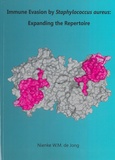Immune Evasion by Staphylococcus aureus
Expanding the Repertoire

Jong, Nienke de
- Promoter:
- Prof.dr. J.A.G. (Jos) van Strijp
- Co-promoter:
- Dr. K.P.M. (Kok) van Kessel
- Research group:
- Strijp
- Date:
- March 29, 2018
- Time:
- 12:45 h
Summary
Staphylococcus aureus (S. aureus) has become a serious threat for human health. Next to having an increased antibiotic resistance, the bacterium is a master in adapting to its host by evading almost every facet of the immune system, the so-called immune evasion proteins. Many of these immune evasion proteins target neutrophils, the most important immune cells in clearing S. aureus infections. The neutrophil attacks pathogens via a plethora of strategies. Therefore, it is no surprise that S. aureus has evolved numerous immune evasion strategies at almost every level imaginable.
In this thesis we aimed to further explore the staphylococcal repertoire that evades the innate immune system. To date, around forty proteins are identified and characterized, but this number is only the tip of the iceberg if we look at predictions. As said before, neutrophils are important for clearing infections caused by S. aureus, but S. aureus can survive within these neutrophils and even use these phagocytes to travel away from the site of infection as so called ‘Trojan Horses’. Before we searched for unidentified evasion proteins targeting one of the granular proteins of neutrophils, we needed to develop tools to study fluorescently labeled bacteria intracellular. We presented integration vectors of S. aureus encoding fluorescent reporters for 6 different colors. There, we described a method to markerless integrate the different fluorescent reporters or use reporter plasmids to study any other promoter of interest for expression studies.
Then, we detected that there is an unknown factor interfering with neutrophil ROS production. We therefore set out a screening method with secretome phage display to discover novel immune evasion proteins targeting the degranulate of neutrophils. There we identified and characterized a protein we named Staphylococcal Peroxidase INhibitor (SPIN), which is a potent blocker of MPO. Thus, the unknown factor observed before is most likely SPIN. The presence of SPIN in S. aureus is important for bacterial survival after phagocytosis by neutrophils, thus SPIN interferes with MPO-mediated killing. Crystallization studies with SPIN/MPO showed that SPIN acts as a molecular plug to prevent H2O2 substrate access to the active site of MPO. We further explored the structure/function relationship between SPIN and MPO. Various mutant of SPIN showed that the C-terminal region is important for binding to MPO, whereas the N-terminal region is dispensable for MPO binding. The N-terminal region is necessary, but not sufficient regarding MPO inhibition. Then, we looked at SPIN homologs in other staphylococci to further understand the molecular features that determine the specificity of SPIN proteins to MPO. There we observed that SPIN from S. delphini is also able to inhibit human MPO, although it shares only ~50% identity to SPIN from S. aureus.
Furthermore, we identified another staphylococcal evasion protein, a novel variant of Staphylococcal Complement INhibitor (SCIN), which is known to interfere with the activation of the complement system and leads to reduced C3b deposition and subsequently phagocytosis. This equine variant of SCIN (eqSCIN) showed to be a potent blocker of the horse complement system and is thereby the first animal-adapted SCIN variant. Modification of this phage-encoded complement inhibitor plays a role in the host adaptation of S. aureus. Finally, we discuss the role of these newly identified evasion proteins and their the therapeutic implications in the general discussion.